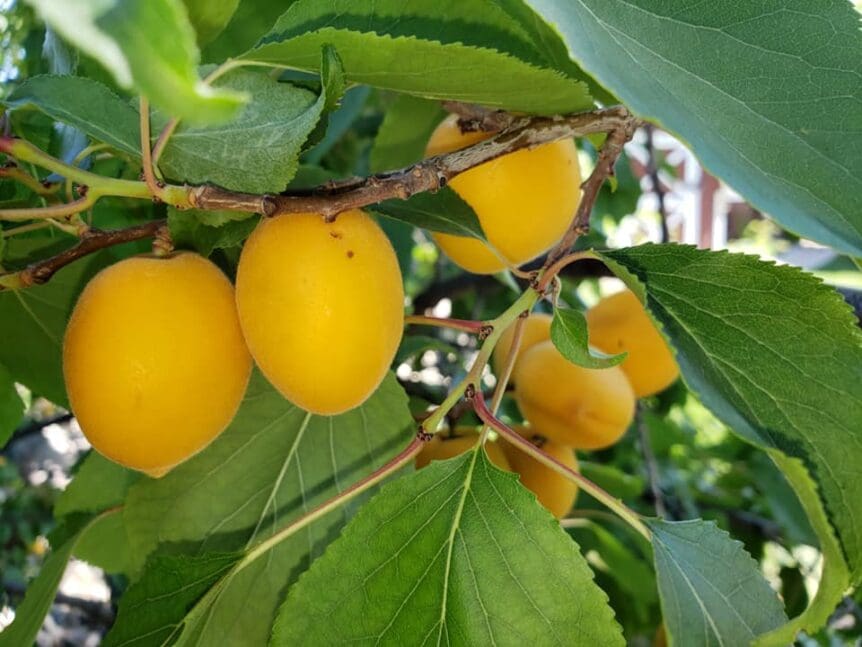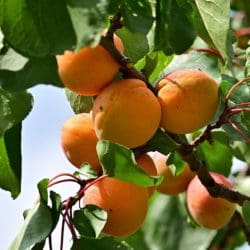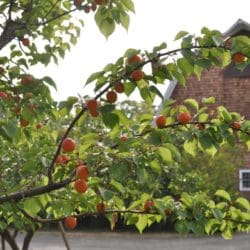Growing Hardy Zone 3 Garden Apricots in Alberta
Manchurian Apricots are a winter-hardy relative of the native plum. This tree can stand some drought, but will not handle standing water or saturated moist soils. They are wonderful trees for conservation and diversity projects, and can be used in shelterbelts, thickets, or as a specimen tree in a sheltered back yard. Manchurian Apricot will attract bees and songbirds. It is the first fruit tree to bear blossoms in the spring. Harvest fruit from July through August, depending on the variety. This tree will produce fruit once it reaches maturity at between two and five years old. There are many successful apricot growers around Alberta. I am aware of fruit production from Bonnyville through Edmonton and down through southern Alberta and Lethbridge. They bloom so early in the spring – you may wonder what pollinates them, as the bees may very well be asleep. Hoverfly and ants are also pollinating insects that can help with Apricot production.
Here’s a list of the top five we recommend trying!
Manchurian Apricot Seedling Strain (Self-Pollinating)
Manchurian Apricot is incredibly cold hardy zone 3 trees! Hailing from Manchuria, this quick growing, medium sized tree can produce fruit in as little as three years! Manchurian Apricots are dark yellow, with a pinkish blush and about the size of a golf ball. These juicy apricots are free-stone, making them excellent for drying, canning and making other preserves. Of course, eating them fresh off your tree is pretty spectacular too!
Well drained, loamy soil is best for Manchurian Apricot trees. They are slightly drought tolerant but cannot handle any long-term saturation of the soil.
Although these trees are very cold hardy, their flowers are susceptible to frost damage! There are a couple of ways to protect your trees and ensure a plentiful crop. You can plant your trees in a sheltered, South-facing micro-climate on your property, where a late frost would be less likely to hit.
Alternatively, plant Manchurian Apricot on a North or East facing slope. This may seem counter intuitive, but the colder Northern positioning will slow the development of flowers, and the Eastern position does not allow for afternoon heating – which forces blooming into the later half of Spring. The slow blossoms will avoid the risk of late frosts.
As these trees are grown from seed, there will be some variation in them, which adds to the diversity of nature, and conservation practices. You can collect and plant your own seeds once they start to fruit!
- Wildlife: Earliest blooming tree, next to willows, for bee habitat. Nesting site for songbirds. Rabbits and other rodents can cause serious injury during winter
- Growth Habit – Spreading. Texture – Medium, summer; medium, winter. Flowers: Blush to Shell Pink.
- Crown Height – 10 to 15 feet Crown Width – 12 to 18 feet Bark Color – Reddish-brown to cinnamon-brown. Root System – Medium in depth, and spread.
Arctic Dawn

(Arctic Dawn is an open pollinated Westcot selection) These apricots are excellent in flavour, freestone and of good size averaging 4 to 5 cm (1.5+”) in diameter. The Arctic Dawn flowers one to two days later than Westcot and ripens in late July. This tree has beautiful fall foliage. Developed at Lumsden, Saskatchewan in a fruit breeding program created by Dean Kreutzer and Tyler Kaban.
- Canadian Hardiness Zone: 3
- Height: 6 meters (20 feet) Spread: 4.6 meters (15 feet)
- Soil Preference: Well drained Light Exposure: Full sun on the tree top. Shade for the roots.
- Pollination: Self-sterile (Needs another apricot tree nearby for best pollination)
- Latin Name: Prunus ‘Arctic Dawn’
RELATED ARTICLES
- Canadian Hardiness Zones are Not the Same as US Hardiness Zones!
- Spring Planting Fruit Trees for the Prairies!
- All Fruit Tree Articles
Casino Apricot
Prunus mandshurica x ‘DurGarfield’ is an open pollinated Manchurian Seedling selected for growing on the prairies. It is a very cold hardy (zone 3) that produces meaty and juicy, smooth tasting fruit, which is great for eating fresh or jams and jellies. Fruit is golden yellow with beautiful red blush and ripens in August. Self fertile, but it is better to plant another variety nearby to pollinate with a different apricot to increase production and yields.
- Mature Height: 16-20 Feet Mature Width: 8-10 Feet
- Full Sun Plant on the East side of an evergreen hedge to avoid afternoon heating – which will result in blooms at frost, and infrequent fruiting.
- Hardiness Zone Zones 3-9
Goldcot Apricot
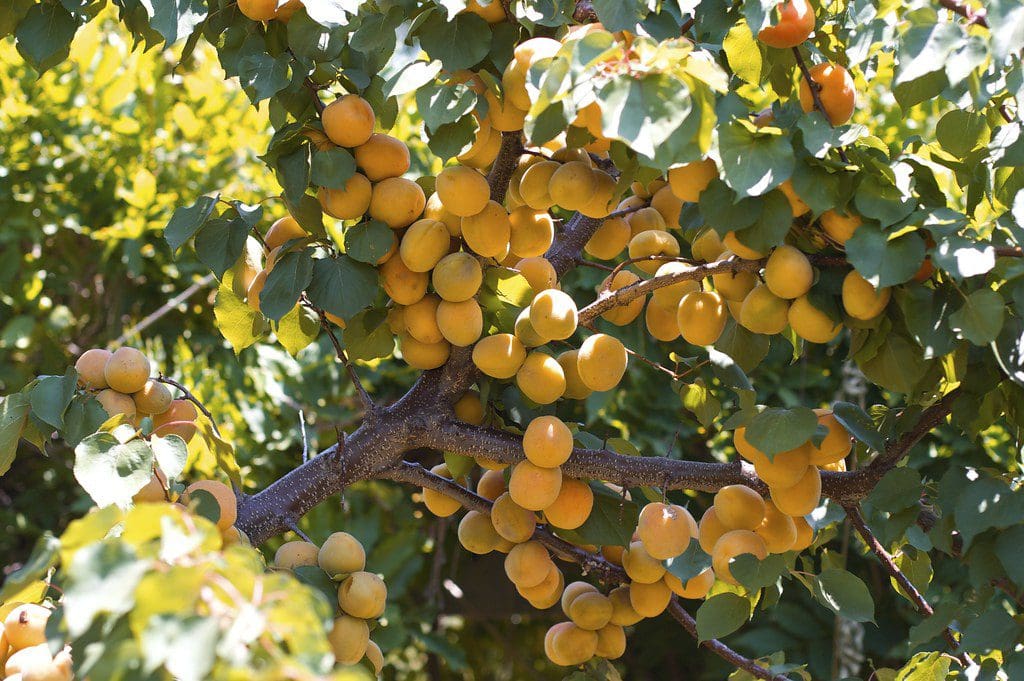
Goldcot Apricot was bred by researchers in Michigan’s snowbelt with the goal of creating a hardier apricot that could withstand harsher winters. They succeeded and Goldcot apricots were introduced in 1967. Both an early and notably hardy cultivar, Goldcot is known to be productive and dependable. The flesh of the fruit is drier than other apricots and has a slight tangy taste that is good for both fresh eating and canning.
- Size: The tree has a natural semi-dwarf growth habit, great for anyone looking for a smaller apricot tree.
- Fruit – Recommended Use: Fresh eating, canning; Fruit Size: Medium; Storage: Keeps 2-3 weeks in the fridge Harvest: Late July
- Canadian Hardiness Zone: 4
- Soil Preference: Fertile sandy loam, loam, lighter clay loam – nothing very heavy. Prefers average to moist conditions with well-drained soils, avoid planting anywhere that floods for more than two weeks in the spring.
- Flowering Time: Middle Bloom Colour: Pink
- Pollination Requirements: Self-pollinating, this variety will produce fruit without an apricot tree of a second cultivar, such as Casino, Manchurian, Debbie’s Gold, Westcot, Arctic Dawn
- Full sun (approx. 8-10 hours of sun daily)
- General Growth Habits: Vigorous and hardy with a compact and upright growth pattern, productive. Resistant to canker and bacterial leaf spot. Though cold-hardy, Goldcot is a bit borderline for our Alberta climate (hardy to -30 degrees), so it requires a more sheltered location and would do better in a warmer micro-climate. As such this variety is not recommended for novice orchardists.
- Ht 15′ tall x Space 12′ wide
Harlayne Apricots
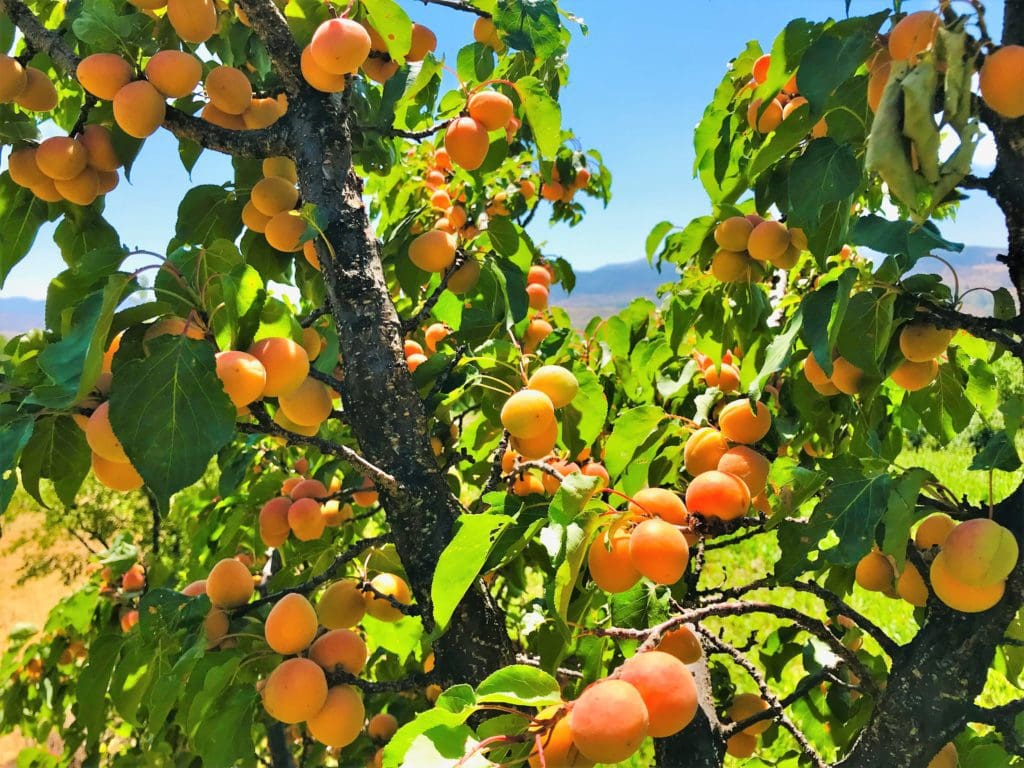
Harlayne Apricots were developed at the Harrow Research and Development Centre in Ontario and released in 1980. It is one of several specifically bred to survive in a southern Ontario climate and of the Harrow apricots it was the most cold hardy in zone 4.
Harlayne is a cold hardy variety that can tolerate temperatures of -30°C. It is a medium-sized apricot and freestone. The skin is a bright orange with an attractive red blush and the flesh is sweet, making it great for fresh eating along with canning or preserving.
- Pollination Requirements: Unlike most of our apricots, Harlayne requires a pollinator such as Casino, Arctic Dawn, Goldcot or Manchurian.
- Fruit Recommended Use: Fresh eating, canning, freezing Fruit Size: Medium Storage: Keeps 2-3 weeks in the fridge Not Ripe until late August.
- Canadian Hardiness Zone: 4
- Soil Preference: Fertile sandy loam, loam, lighter clay loam – nothing very heavy. Prefers average to moist conditions with well-drained soils, avoid planting anywhere that floods for more than two weeks in the spring. Flowering Time: Middle Bloom Colour: Pink
- Head of Tree needs Full sun (approx. 8-10 hours of sun daily) , Plant roots into the shade so they don’t bloom too early.
- General Growth Habits: Moderately vigorous. Resistant to brown rot, canker, and bacterial leaf spot.
Westcot
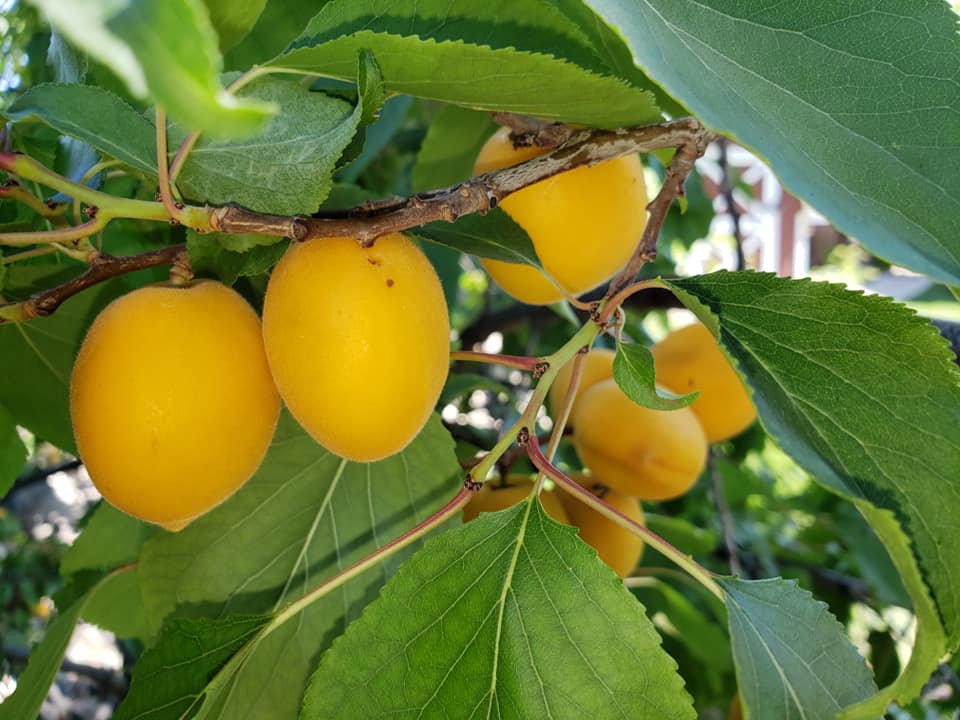
A hardy, semi-dwarf tree with very large 1.5″ apricot with showy pink flowers in early spring followed by golden fruit blushed red in mid-summer; recommended pollinator is Casino Apricot; plant in a sheltered area as flowers can be damaged by late spring frosts.
Fruit: It produces yellow round average size apricot fruit (technically ‘drupes’) with a red blush and yellow flesh which are usually ready for picking in late summer. Note that the fruits have hard inedible pits inside which must be removed before eating or processing. The fruits have a sweet taste and a firm texture. The fruit are great for Baking Eating Fresh out of Hand and Preserves
Westcot Apricot is covered in stunning clusters of fragrant shell pink flowers along the branches in early spring, which emerge from distinctive pink flower buds before the leaves. It has green deciduous foliage. The pointy leaves turn yellow in fall.
The fruits are showy yellow drupes with a red blush, which are carried in abundance in late summer. The fruit can be messy if allowed to drop on the lawn or walkways, and may require occasional clean-up.
This is a deciduous tree with an upright spreading habit of growth. Its average texture blends into the landscape, but can be balanced by one or two finer or coarser trees or shrubs for an effective composition. This plant will require occasional maintenance and upkeep, and is best pruned in late winter once the threat of extreme cold has passed.
Westcot Apricot will grow to be about 15 feet tall at maturity, with a spread of 12 feet. It has a low canopy with a typical clearance of 4 feet from the ground, and should not be planted underneath power lines. It grows at a medium rate, and under ideal conditions can be expected to live for 50 years or more. This variety requires a different selection of the same species growing nearby in order to set fruit.
This tree is typically grown in a designated area of the yard because of its mature size and spread. It should only be grown in full sunlight, but where it’s roots are in the shade where the snow stays the longest in the spring. It does best in average to evenly moist conditions, but will not tolerate standing water. It is not particular as to soil type or pH.
It is highly tolerant of urban pollution and will even thrive in inner city environments, and will benefit from being planted in a relatively sheltered location.
This is a selected variety of a species not originally from North America, meaning that it does not go dormant on daylength, only on cooling temperatures. Take special care to mulch the roots of young trees to keep the roots cold and dormant during unseasonable warm snaps in the early spring.
We have a friend with a full orchard of mature Apricots in Lethbridge. They grow beautifully in her sheltered city yard. It has also been used as boulevard trees along the Capilano Freeway (now called Gretzky Drive) in Edmonton with excellent success!
HOW TO DELAY FLOWERING IN APRICOT TREES
After tasting fresh Westcot – I can vouch for them! AWESOME taste, VASTLY SUPERIOR to any store bought apricot! However if we simply plant an apricot tree in the sun as we would an apple tree or a plum or pear tree, we will be lucky to get fruit once every 5 years, probably only once every 10 years. This is due to apricots blooming very early, the last week in April every year, and the flowers freezing in Alberta since we still get plenty of frosts in late April and early May.
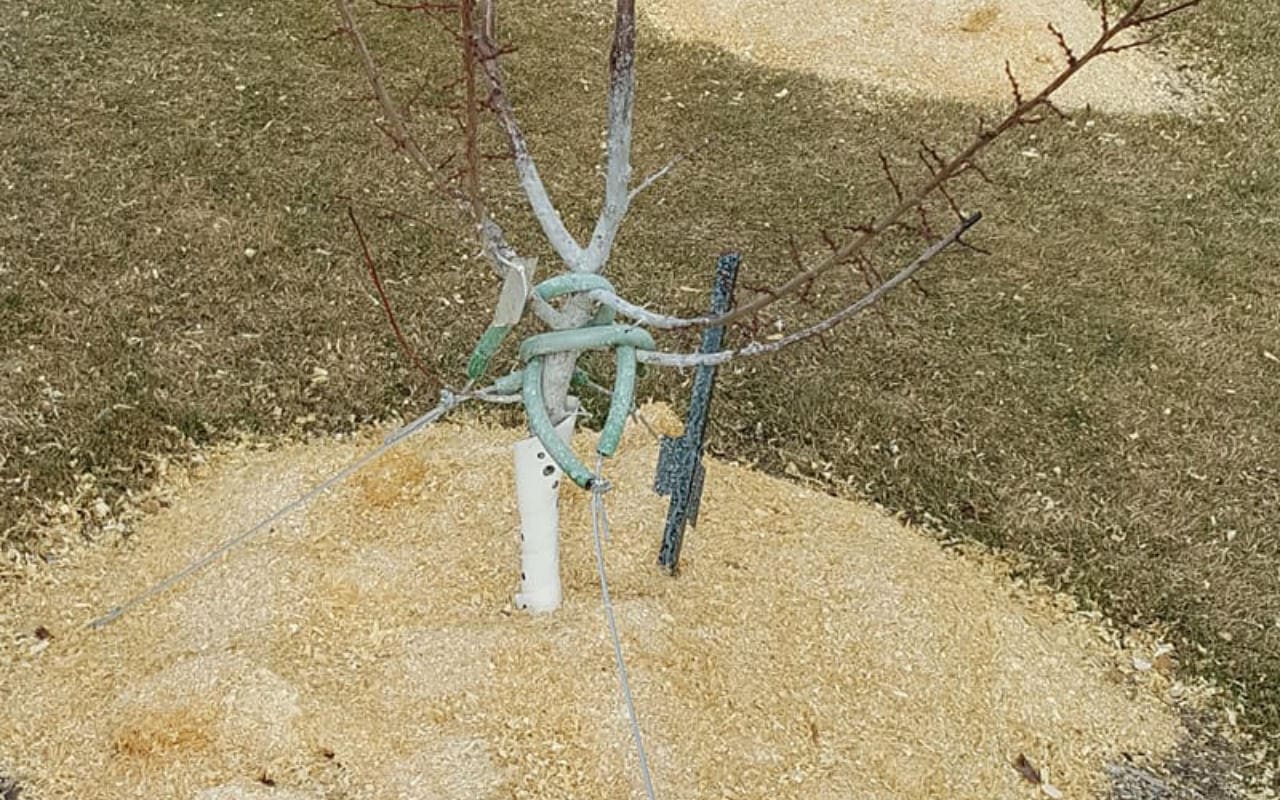
Try planting your apricot tree where the trunk won’t see much spring sun. But you don’t need to completely shade the tree, just around the base. The idea is to keep the ground cool and prevent warming. Piling up some snow and adding leaves around the base will also help. This may give you up to an extra week or two before it flowers. Watch for the place in your yard where the snow stays the longest in the warm days of spring (That is not on the north side in full shade). That is where you should plant your roots, so the tree top can grow up into the sun!
These tips will help a lot to get fruit more often:
- Always plant your apricot tree on the NORTH side of your house or garage, or at least the north side and close to a tall fence. This may seem counter intuitive as fruit trees like full sun. However in Alberta you want the ground and trunk of the apricot tree to be totally shaded from the direct sun until early to mid May when the sun gets higher in the sky. This keeps the trunk and ground cooler and longer to warm, which in turn means the apricot tree blooms days later than if it is in the full sun in spring. This means the blossoms have a better chance of escaping frosts
- There has been a lot of experimentation in the USSR in growing fruit out-of-zone, in search for self-sufficiency. They invested hugely in growing lemons in the northern USSR as a source of vitamin C during war years. They say they can delay apricot blooming by two weeks by shoveling the snow away from the trees to the dripline until early/mid December. This allows the soil temperatures to drop a bit colder than the usual -5C we see under a blanket of snow. They then add straw bales or bags of leaves (protecting the trunks with hardware wire by with wrapping around it to protect from mice and from voles), and cover with snow. The ground insulation is not removed until the trees bloom, which is about 2 weeks later than normal due to the soil being deeply frozen plus the ground insulation keeping in the cold. While this will take a bit of extra effort, if we only have a tree or two in the backyard, easily doable.
See Our Apricot Tree Options and Order Yours Today!
-
Westcot Apricot
$95.00 – $155.00 Select options This product has multiple variants. The options may be chosen on the product page -
Casino Apricot
$95.00 – $185.00 Select options This product has multiple variants. The options may be chosen on the product page

